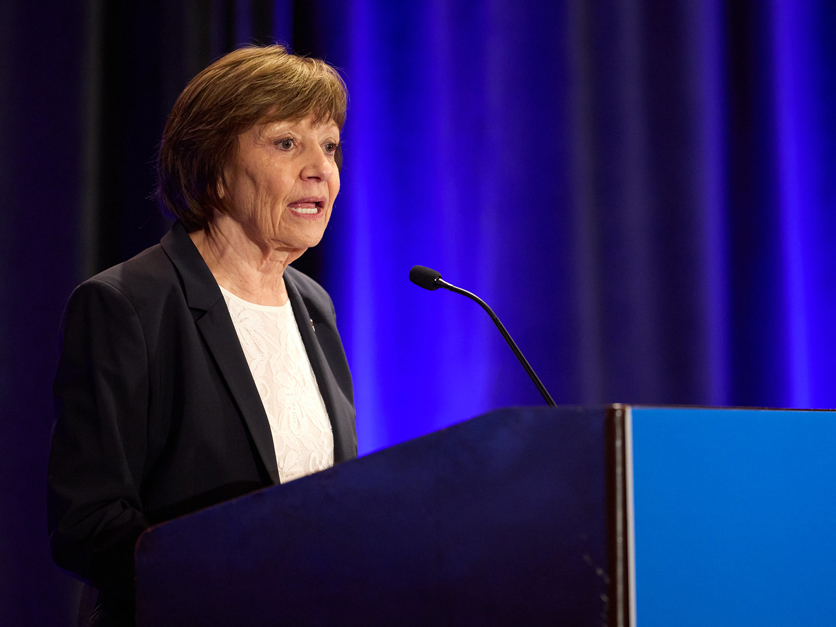Both the U.S. pork industry and the California Department of Agriculture are focused on a smooth transition and avoiding product shortages for consumers as the state implements regulations requiring all pork sold in the state to be from breeding animals not housed in gestation crates.
The Supreme Court’s May 11 decision upholds California’s Proposition 12 ballot initiative which requires enough space for breeding pigs to lie down, stand up and turn around freely with at least 24 square feet of space. Only whole, uncooked pork cuts, like bacon or tenderloin, have to be Prop 12-compliant, while all the other 42% of the pork consumed in the state from products such as ground pork, sausage, precooked pork or deli meat do not require changes.
“We’re not anticipating a bacon shortage,” California Secretary of Agriculture Karen Ross told Agri-Pulse. But she added she won’t talk about the likely resulting increases in prices for that bacon as she recognizes the requirements will bring higher costs to the consumer.
CDFA is working to ensure there’s an adequate supply of pork in stores and restaurants as it transitions to a July 1 deadline for distributors to register with the agency. Under the new rules, each facility distributing or selling products covered under the California law is required to register with CDFA.
Ross said they’re encouraging all distributors to register and submit a self-certification of compliance by the July 1 date, which was listed in the original regulations, but no enforcement action will be taken with pork already in the pipeline. After Jan. 1, 2024, or 12 months from that initial registration, CDFA said all distributors will need to resubmit with a valid third-party certification.
“We’re the implementer; we’re not the enforcement,” Ross said as the agency focuses on working to bring distributors into compliance where hundreds have already registered. She said the agency wants to create a transition that works to “avoid any food waste or dumping, because there’s no way to verify everything that’s in the pipeline right now.”
 California Ag Secretary Karen Ross
California Ag Secretary Karen RossScott Hays, president of the National Pork Producers Council, told Agri-Pulse they’re encouraged by the actions taken by CDFA to avoid a July 4 holiday in California without pork. In recent weeks, CDFA has hosted webinars for retailers and processors, with another one planned for producers on June 27.
Hays said they’re concentrating on helping with a smooth transition to keep pork flowing into California. “We’re worried about our consumers out there, but we also need to keep product moving for our producers,” Hays said, as pork producers are seeing an average $40 loss on every pig.
The costs to update production facilities to comply with Prop 12 couldn’t come at a worse time for pork producers facing depressing economic conditions not seen in the last 25 years driven by rising feed and input costs and labor shortages. Hays said higher building costs and limited profitability in the hog sector may keep many producers on the sidelines instead of making investments to become Prop 12-compliant.
“Anything that increases costs in an environment where there’s ongoing contraction, you’re likely going to see further contraction,” said Lee Schulz, Iowa State University associate professor and extension livestock economist.
In March 2021, Rabobank estimated less than 4% of U.S. sow housing was able to meet the new standard. Schulz said that number may be closer to 7-8% today, but still below the needed levels to meet California's current pork demand.
Schulz said a new gestation facility or retrofitting a facility has a 15 to 20-year useful life. When producers lock in premiums from packers in agreements made today, they need to cover their costs over 15 years to pay back that investment.
“I think that’s a concern for a producer when looking at what levels of premiums you need for the long term just to pencil out that investment,” Schulz said.
Northwest Iowa pork farmer Dwight Mogler has been raising hogs since 1976 and owns farms in Iowa and as a partner in South Dakota that have varying degrees of space for breeding hogs. Because of his high standard of care for his animals, as well as the need to remain a profitable business unit, each farm he’s made different decisions on whether to sell into the California market.
“As an industry, we must continue to fight for the freedom to operate and for the ability to not have to compromise our animal welfare ethics and that we can actually take care of the animals as they have been intended to be cared for,” he said.
As an investor in a jointly owned farm in South Dakota, they determined the cost of Prop 12 compliance was likely $15 per head higher than the premium the processor was willing to pay. “We were $15 apart during negotiations, plus we were really struggling with a violation of our animal welfare ethics that we could even manage group housing of the sow when going through her heat cycle,” Mogler said, so he decided not to sell into the California market at that facility.
Don’t miss a beat! It’s easy to sign up for a FREE month of Agri-Pulse news! For the latest on what’s happening in Washington, D.C. and around the country in agriculture, just click here.
At another farm, they did strike a deal with a processor on premiums that Mogler said was “amicable,” but there are still many unknowns on what the true cost of production will be at that facility. In 2014 they began upgrades to the 5,200-sow facility with initial costs of $12 million, but in 2022 it took an additional $8.7 million to make that farm Prop 12-compliant after constructing a new building to gain enough square footage.
California also only allows sows to be alone for a maximum of six hours per day or a maximum of 24 hours within 30 days. Mogler’s farm features free access stalls so the animals can go in and out of the group stalls. The animals’ natural behavior is to spend about 80% of their time inside those individual stalls, he said, as the hogs prefer safety and protection from other hogs.
After Mogler’s farm became Prop 12-compliant and breeding animals were no longer able to spend that time alone, conception rate dropped from 96% to 70% in February and March. If lower birthrates continued it would significantly impact the farm’s ability to produce 150,000 pigs per year.
“We believe we learned a few things, and we have recovered significantly, but mainly the solution for us has been to feed the sows twice the amount of food we would normally feed them during their first 30 days of their gestation period,” he said.
Now faced with higher feeding costs, constant access to feed also results in an over-conditioned animal, which “compromises her ability to successfully birth or litter” with an increased number of stillbirths, Mogler said.
“So even today, we do not know what our true costs of production increases will be on that Prop 12 farm,” he said, but estimated the cost is about twice the amount of the premium he agreed to at the time.
Ross said she’s received assurances from major processors that are “confident that they’ve got adequate supply” to meet California’s anticipated pork demand, which is estimated at 13% of total U.S. pork consumed. But Schulz said there may also be a shift in what pork products are sent and consumed in California, which could create ripples in other markets or segments of pork demand.
“California doesn’t consume pigs. They consume pork. They may consume a lot more than 13% of certain cuts. And so what that means is that production actually has to be a lot greater to meet that market,” Schulz said.
The market shift could significantly weigh down prices for producers who are not Prop 12 compliant, and the rest of the product must either be absorbed in the U.S. market or exported. Mogler doesn’t have a guarantee that he will sell all of his Prop 12-compliant pork into the Californian market.
California consumes high amounts of bacon and ribs, but fewer hams and loins. “We have raised the cost of pork significantly because the retailers are going to have to pay a lot more when there’s not enough bacon,” he said as an example. “I would predict that the price of bacon will more than double in California, but the price of hams may hardly be affected.”
 Dwight Mogler
Dwight MoglerEach processor has different space requirements to qualify for their own marketing claims, but California’s 24 square feet is larger than many existing standards for group or loose housing across the industry.
In a recent earnings call, Hormel Chairman, President and CEO James Snee said as of January 2022, it had become Prop 12-compliant on a portion of its pork supply, absorbing the cost of compliance in its operations since that time. “As we begin serving the important California market under new regulations later this month, we expect to begin recovering the cost from these investments,” Snee said, with an anticipated net sales growth of 1-3% as a result.
Early on, Smithfield committed to group-housing systems for sows in its company-owned operations and invested $360 million to convert their farms over 10 years. The firm also encouraged all its independent contractors to make the shift.
“This conversion was celebrated, but now the goal posts have been moved,” Ray Atkinson, director of external communications at Smithfield, said in an email to Agri-Pulse. “Not only have the goal posts moved, but they’re moving differently in different states. A patchwork of state-by-state regulations — which have not been informed by science or animal welfare experts — is not conducive to an efficient food production system that keeps food affordable for consumers.”
Atkinson said Smithfield supports federal legislation “that establishes a science-based, national animal welfare standard" and is "needed to ensure the cost-efficiency of our food system.”
Mogler, who also serves on NPPC’s board of directors, said he’s pleased to see NPPC advocating for a legislative solution included in the farm bill to avoid the patchwork approach. The Exposing Agricultural Trade Suppression (EATS) Act introduced by Sen. Roger Marshall, R-Kan., would prevent states or local governments from setting agricultural production standards elsewhere. Iowa Gov. Kim Reynolds and Nebraska Gov. Jim Pillen led a coalition of 11 states representing over half of the country’s pork production in writing a letter to congressional leaders urging their support for the EATS Act.
“We need to ride this wave of awareness and push through a legislative fix that squashes not only Prop 12, but squashes Massachusetts’ Question 3, and is a long-term fix for ever allowing this type of thing to happen again,” Mogler said.
He hopes to get the legislation in the upcoming farm bill but recognizes it will not be an easy inclusion and recalls previous failed attempts by former Rep. Steve King, R-Iowa.
Sausage making is probably better done behind closed doors, and the same can be said for the legislative process, Mogler quipped.
“NPPC is supporting EATS as the best legislative solution that exists today, when we have full recognition and understanding that when we’re in the dark room behind closed doors making sausage, that the final product that comes out the other end of the press will not be the EATS Act.”
For more news, visit www.Agri-Pulse.com.


